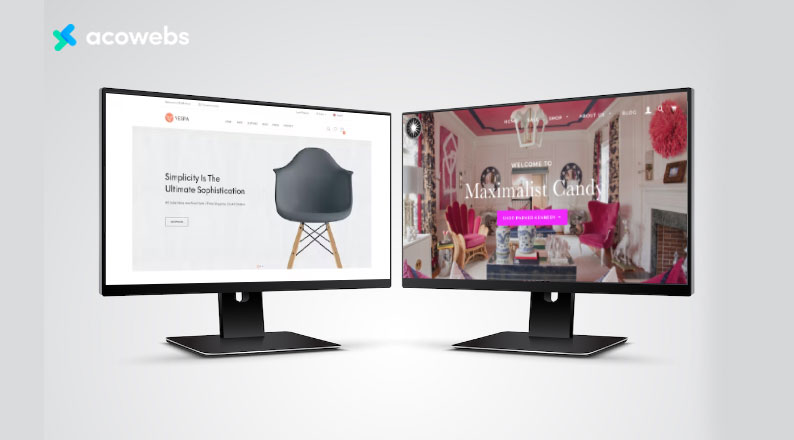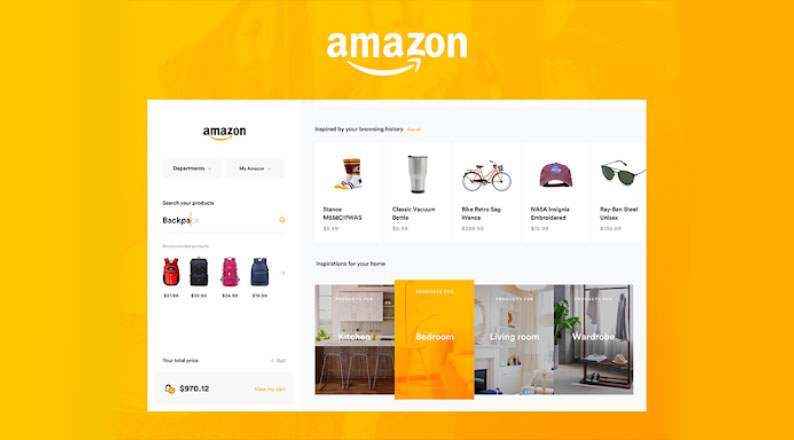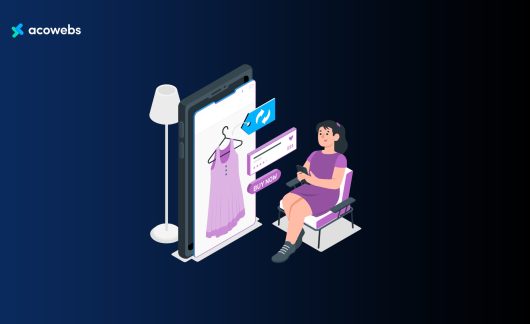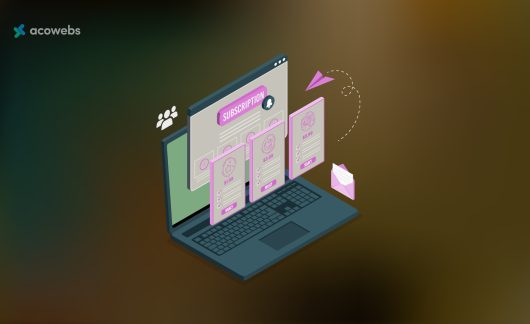Do you feel overwhelmed when you look at a minimalistic eCommerce store? Or does a maximalist approach to design make you feel more energized? Minimalism vs. Maximalism is a popular debate regarding the better choice for eCommerce store design.
If you own an eCommerce store, you may wonder which design style is better for you. Minimalism is often associated with sleek, modern design and can create a sense of luxury and sophistication. It’s the perfect choice for stores selling high-end fashion, luxury, and other items that require a more discerning eye.
On the other hand, maximalism is associated with bold, vibrant designs and can create a sense of fun and excitement. This makes it great for stores selling items that require a more playful approach.
This article will explore the pros and cons of minimalism and maximalism in eCommerce store design. We will examine how the two design styles affect user experience, customer engagement, and overall sales.
What Is Minimalism?
Minimalism is a lifestyle and mindset that encourages individuals to discard excess possessions and materialistic values and instead focus on what is truly meaningful in life. It helps individuals find freedom from fear, worry, overwhelm, guilt, and depression.
It is not defined by having few possessions or following strict rules; instead, minimalism involves making thoughtful decisions about the items we choose to own and the activities we engage in. It allows one to pursue a life of purpose, joy, and fulfillment through health, relationships, passions, and contributions beyond oneself.
Ultimately, minimalism is about finding lasting happiness through life rather than material possessions or activities.
What is Maximalism?
Maximalism is a design style that has been around for centuries but has seen a significant resurgence in recent years. It is an art and design style that incorporates many elements and details. Bright colors, bold patterns, and textures often characterize this style. It is a form of expression that is unapologetically bold and complex.
The wealthy have long displayed their riches through maximalism, and the Victorian era saw a particular emphasis on the practice. Thanks to a recovering economy, younger generations have become enamored with the idea of showing off their favorite things, and social media has further popularized the style.
Maximalists are like curators of their own space, carefully selecting and arranging objects to create a unique, personal atmosphere. With proper thought and care, maximalism is easy to achieve in the home and can add vibrancy, personality, and charm to any space.
Minimalism vs. Maximalism in eCommerce

Which is better choice for your eCommerce store? It takes careful consideration to develop a successful e-commerce website. In order to give users a great experience, the site’s appearance and feel must be carefully considered.
A captivating and user-friendly ecommerce website requires selecting the proper design components. Also, the type of web design will be directed by the demand of your needs.
What Is Minimalist in eCommerce Design?
Minimalist eCommerce design is a popular approach to web design that seeks to provide customers with a streamlined, intuitive, and efficient online shopping experience.
By focusing on simple, uncluttered visuals and navigation, customers can quickly identify the items they are looking for and make a purchase decision.
Minimalist e-commerce design emphasizes using clear and concise product information, such as product descriptions, photos, and prices, to ensure customers have all they need to make an informed decision.
The streamlined checkout process allows customers to complete their purchases quickly and easily. In addition, minimalist e-commerce design emphasizes providing customers with an aesthetically pleasing experience, ensuring that the design is modern and aesthetically pleasing.
A great example of minimalist e-commerce design is Amazon’s website. The homepage is simple and uncluttered, with products and categories clearly highlighted. The navigation is intuitive and easy to use, and the checkout process is quick and straightforward.

Amazon Homepage – Image Source: Pinterest
Characteristics of Minimalism
- White backgrounds. White backgrounds best contrast the background and any text, calls-to-action, and other foreground elements. Users can perceive the content clearly, and uncluttered thanks to this, which can help guarantee that messaging has the greatest impact.
- Bold colors. Bold colors can be used as backdrops or accents to generate contrast and aid in communicating message and emotion. This can be powerful when placed against a black or white background.
- Tidy typography. A fantastic method to make text stand out is to use sans-serif fonts in conjunction with large font size and bold font weight. This ensures that messaging has a possible impact and makes it simpler to scan and read.
- Whitespace. A crucial component of minimalist design is empty or negative space. It can be used to urge users to do a particular action and aids in directing viewers to where they should focus. This can make websites easier to browse, skim, and read.
Pros of Minimalism
Minimalism is a better choice for your eCommerce store, depending on your needs. Below are the benefits you enjoy when using a minimalist approach.
Easy Navigation
Navigating your website should be an effortless experience for your visitors. With the aid of a clear, uncluttered design, your visitors should be able to quickly and easily obtain the information they require and execute the action they desire.
Make sure your navigation is simple by using a basic, uncomplicated structure and providing a clear title for each page. Use drop-down menus, breadcrumbs, and search boxes to help visitors quickly discover what they’re looking for.
Additionally, ensure your website is responsive to mobile devices to enable easy access to your sites from any device. Adopting uncomplicated and user-friendly methods may give your visitors a relaxing and enjoyable experience while increasing conversions.
Clear Communication
Simple language and a minimalist approach enable you swiftly and effectively convey your brand message to your visitors.
With this strategy, you may concentrate on your message’s essential points without becoming mired in redundant information. As a result of being simpler to digest and comprehend, this might help make your message more remembered.
Additionally, it pushes customers to take action and contributes to the overall favorable perception of your business.
Less Loading Time
eCommerce sites with a minimalist design aim to be as streamlined and effective as possible. They just include the bare minimum of components required to give clients a practical shopping experience.
This involves getting rid of extraneous photos, videos, and other components that can prolong the loading time of a website. Minimalist websites can load faster and give users a better overall experience by limiting the amount of stuff on the page. Because visitors are more likely to stay on a page that loads quickly, this lowers the bounce rate.
Improved SEO
Minimalist sites are generally less cluttered, making it easier for search engine bots to crawl through, index, and understand the content on your site. This can help your website appear higher in search engine results, leading to more organic traffic.
Additionally, a minimalist design can make your website look more modern and appealing to visitors, increasing your chances of attracting and retaining visitors.
Easy Website Maintenance
Website maintenance involves regularly updating and optimizing a website to keep it running smoothly and securely. This includes software upgrades, security patches, backups, content updates, website optimization and marketing, and customer service.
A website that is minimalist in design has fewer components and functions than one that is more complex. This makes it simpler to maintain because there is less code to manage and less chance of broken components.
Furthermore, a minimalist website often has fewer moving parts, facilitating faster problem-solving and diagnosis. Because of this, a minimalist website is frequently easier to fix and less likely to malfunction.
Cons of Minimalism
When it comes to minimalism vs. maximalism, each has its shortcomings. Let’s look at those of minimalism.
- Lack of visual clues: Visual cues are essential for minimalism since they help users understand the process. Without them, clients could easily feel perplexed or overwhelmed, which would decrease conversion rates.
- Absence of personality: Minimalism lacks the ability to show off a company’s personality and brand fully. This may make it hard to connect emotionally with customers without visual information.
- Limited Functionality: Minimalism is fantastic on the surface, but it can also restrict what can be done. A website’s basic design may make adding new features or information challenging without compromising aesthetics.
- Poor Searchability: Search boxes and other navigational elements that make it easier to find products or information are frequently absent from minimalist designs. Customers may find it difficult to find what they’re seeking fast as a result, which may result in missed sales.
Maximalism in eCommerce Design
Maximalist e-commerce design is a method of online design that stresses the usage of numerous components, hues, and fashions to overwhelm and excite website users aesthetically.
Instead of relying solely on white space, it emphasizes using information and elements like text, photos, and video to fill the available area.
When done well, Maximalist design may produce a visually stunning and engaging experience, but when done poorly, it can be overwhelming, result in a high bounce rate, and negatively impact conversion rates.

Maximalist design – Image Source: Toptal
Characteristics of Maximalist
- Bold color combinations: This refers to the use of solid and vibrant colors in combination with each other to create a visually striking aesthetic. Bold and bright colors create a sense of drama and excitement, while muted, pastel colors create a more relaxed atmosphere.
- Contrasting patterns and motifs: This involves using different patterns and motifs to create visual interest and contrast.
- Repeated elements: This involves using elements repeated throughout the design to create a cohesive aesthetic. Repeated elements are used to create visual harmony and a sense of continuity.
- Little white space: This refers to the use of minimal white space, as maximalist designs tend to be busy and filled with elements. This creates a sense of energy and dynamism while allowing the design to remain balanced and organized.
- Layered images: This involves using multiple layers of images, patterns, and textures that work together to create a unique design. Layering images can create depth and complexity, giving the design more visual impact.

Layered design – Image Source: Webflow
- Dense text and multiple fonts: This involves using dense text and multiple fonts in the same design to add visual interest and complexity. Using multiple fonts can be a great way to add a unique, creative touch to a design.
- Create fantasy: This refers to creating a dream-like atmosphere through bold colors, contrasting patterns, and layered images. This can help to create an otherworldly feel and transport the viewer to a different place.
Pros of Maximalist
Maximalism is a better choice for your eCommerce store for the following reasons.
Increased Engagement and Customer Loyalty
Maximalist web design is a style that emphasizes employing vivid colors, huge fonts, and other graphics to grab attention and keep viewers interested. Websites may attract visitors and keep returning by designing them with a maximalist aesthetic.
Customers will likely return to a website they thought to be visually appealing and interesting, promoting a sense of loyalty. Additionally, a maximalist style encourages users to explore more of the website, which can further boost user engagement.
Increased Brand Recognition
Maximalist designs make websites instantly recognized and memorable, which promotes brand awareness. Websites may achieve a distinctive and captivating visual identity that will stand out from the competition by using a creative layout, strong graphics, and brilliant colors. Additionally, this can produce a memorable user experience that benefits consumers and brand loyalty.
Variety of Content
A maximalist design gives businesses a powerful tool to create a visually appealing and engaging website. Through this, businesses get to give their clients a richer experience and more information about the goods and services they offer by providing a range of content.
This not only assists in bringing in more visitors but also motivates them to explore the website and take action. Businesses may build an immersive experience that keeps customers interested and drives sales by providing a variety of material.
Improved User Experience
The maximalist design allows for maximum information to be conveyed in a concise and organized manner. This helps users quickly and easily find the information they need, leading to a more satisfying experience.
It also allows for a more engaging experience, as the user can explore and interact with the website. Using a maximalist design, websites can provide an interesting and enjoyable user experience that can help increase satisfaction and customer loyalty.
Increased Conversion Rates
By providing more information and visuals, customers are able to understand the product or service more clearly, allowing them to make an informed decision about the purchase. Maximalist design can help to create an immersive user experience, which can help to engage customers and encourage them to make a purchase.
By creating an attractive and engaging experience, customers are more likely to complete a purchase and become loyal.
Cons
- Increased overhead: Unlike minimalist designs, creating and managing maximalist designs can be more expensive and time-consuming. The more significant number of components and functionalities that need to be updated and managed is the reason behind this.
- Potential overload: A maximalist design with too many features may leave customers feeling disoriented or overwhelmed. Customers might be unable to quickly find what they’re seeking, resulting in a greater bounce rate.
- Longer load times: A page may take longer if you add more elements. Due to their increased expectations for page load times, mobile customers can experience this as a particular concern.
- Poor User Experience: A maximalist design may make it more difficult for visitors to navigate the website due to the abundance of elements. This may result in a bad user experience, making it challenging for customers to finish their transactions.
Which Approach Is Better for Your Ecommerce Website?
When choosing between a minimalist or maximalist approach for an ecommerce website, there are several factors to consider. The brand should be considered, as well as the type of items being sold.
A minimalist approach may be best for mature, established brands selling luxury items, while a maximalist approach may be better for digital shops selling sports merchandise and art-related items.
Additionally, the target audience should be considered, as different age groups may prefer different levels of visual complexity.
Conclusion
Minimalism and maximalism are two approaches to ecommerce design. Minimalism focuses on uncluttered and straightforward user experiences, and maximalism emphasizes bold visuals and creative elements to create an engaging and immersive user experience. Both approaches create unique and memorable user experiences and help draw the user’s attention.
Minimalism is best for stores selling high-end fashion, luxury, and other items requiring a more discerning eye. At the same time, maximalism is excellent for stores selling more affordable items, items that require a more playful approach, and items that appeal to a broader range of shoppers.
Ultimately, the choice between the two design styles comes down to the needs of your eCommerce store, the type of products you are selling, and your target audience. Minimalism and maximalism both have pros and cons, but with careful thought and consideration, you can create a design that suits your needs and appeals to your customers.
Acowebs are the developers of WooCommerce Product Labels let you include custom product labels or product badges for the Woocommerce products. Woocommerce product label plugin provides you with different label styles and customizations for labels. Woocommerce sale badges can create easy-to-use UI to add labels to the selected products or categories. It also has developed plugins like Woocommerce Quick View Plugin that helps users to make a quick look at the products rather than opening the entire product page.












 Login
Login
 Cart
Cart







